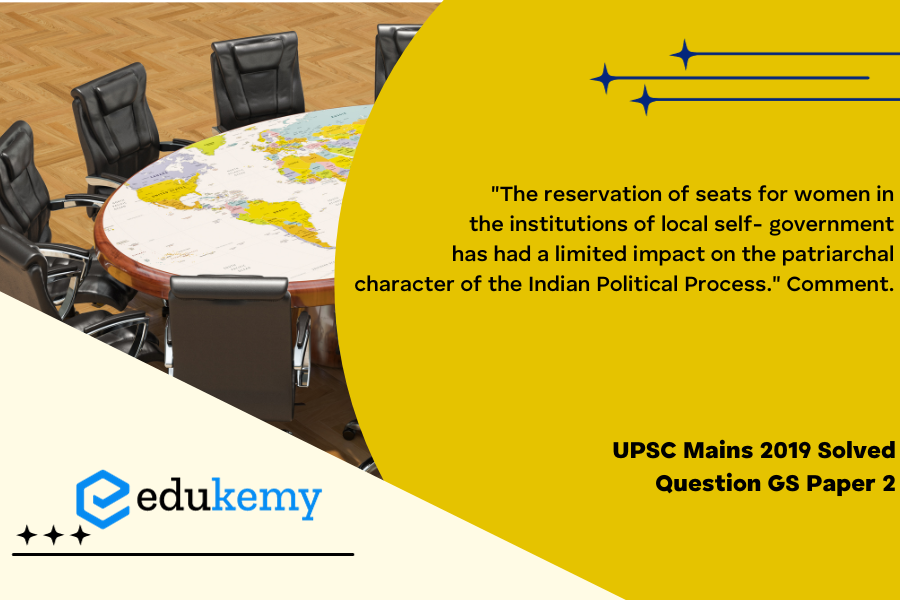The reservation of seats for women in the institutions of local self-government marks a significant step towards fostering gender inclusivity in the Indian political landscape. Introduced to address the historical underrepresentation of women in decision-making processes, this policy has undoubtedly brought some positive changes. However, the impact of such reservations on the deeply entrenched patriarchal character of the Indian political process has been limited. While the provision has resulted in an increased number of women occupying seats in local bodies, the broader transformation of the political culture remains gradual. Despite women’s formal presence, the substantive power dynamics often continue to reflect deeply ingrained patriarchal norms and attitudes.
One of the challenges lies in the persistence of tokenism, where women may occupy reserved seats without exerting significant influence on policy decisions. The actual empowerment of women leaders necessitates not just numerical representation but also a genuine shift in the mindset and power structures within these institutions. Additionally, women often face hurdles in accessing resources and networks that are essential for effective political participation. The patriarchal underpinnings of society, including discriminatory cultural norms and stereotypes, persist and impede the full realization of women’s potential in the political arena.
Tag: Devolution of powers and finances up to local levels and challenges therein.
Contents
Decoding the Question:
- In the Introduction, try to briefly write about Local self-government and representation of women.
- In Body,
- Discuss how the reservation has a limited impact on the patriarchal character of the Indian Political Process.
- Also, mention some positive impacts of reservation.
- In Conclusion, try to write the significance of women’s participation in local self-government.
Answer:
A million women have been elected at the village, block and district levels, following the 73rd Constitutional Amendment which reserved 33 percent of seats in Panchayati Raj Institutions for women. The process of decentralization has provided representation but representation has not always led to their participation in the Indian political process.

Limited Impact of Reservation of Seats for Women:
- The lack of time seems to be the most widely shared problem faced by women politicians. Studies conducted by an urban local body reveal that elected women continued to perform all those duties that are expected of a full-time housewife.
- The elected women lack of training; only a few of the women representatives received formal training for their job.
- The women have less experience in politics and exercise their political responsibilities, which hinders their participation.
Patriarchal Character of Indian Political Process:
- The practice of “Sarpanchpatis”: The effective political power and decision-making are wielded by husbands or other male relatives of elected women representatives. This makes the intended empowerment of women through reservation infructuous.
- Rubber stamps: Most of these women are just rubber stamps with the men in their house- can be the husband, father or son – running the show. They also work as proxies for rural elites hence restricting their autonomy.
- Lack of exposure of women themselves to politics and the absence of any experience in exercising their political responsibilities hinder their participation. Since most women are illiterate and do not have any training in handling technical issues and financial deals, they have no option but to take assistance from male family members.
- Stereotypes and traditional norms: This relegates women to the domestic sphere and dissuades them to engage in public affairs. Caste and class factors also play a key role that restrict women to take leadership roles.
- The burden of household responsibilities, purdah (veil) system, etc adversely affect their performance.
Positive Impacts of Reservation of Seats for Women:
- The reservation of seats has provided fertile ground for the long-term political empowerment of women.
- In some areas, women representatives have done considerable development work on the ground. For example, the women sarpanch of Dhani Miyan Khan Gram Panchayat in Haryana built a training center for women and ensured girl child education.
- Elected women representatives are also more accessible than their male counterparts.
- Studies also showed that the representation of women in the organizations reduced corruption and ensured transparency and accountability.
- The reservation of women at the local level had various social and developmental impacts like sanitation drive, promotion of nutrition, behavioral changes, etc.
Way forward:
- Capacity Building of Elected Women Representatives (EWR) and Functionaries of PRIs: This would prepare women to discharge multiple roles, enabling them to raise local priorities to the planning process.
- Strengthening women’s groups and building networks: Formation of women’s forums and networks to develop a sense of solidarity amongst the women.
- Institutionalization of mechanisms to strengthen the capacity building of EWRs to better understand and perform their functions.
- Mobilization of community and strengthening the processes of constituency building to enable women to better articulate their voices and participate in the electoral process.
The quota policy for women in local government increases candidacy for, but not the representation in, State and national political offices. Through active participation in the local bodies and the development programs, the women will grow in social awareness and political consciousness and will turn out to be active agents of the democratic order and activists of a silent democratic revolution.
In case you still have your doubts, contact us on 9811333901.
For UPSC Prelims Resources, Click here
For Daily Updates and Study Material:
Join our Telegram Channel – Edukemy for IAS
- 1. Learn through Videos – here
- 2. Be Exam Ready by Practicing Daily MCQs – here
- 3. Daily Newsletter – Get all your Current Affairs Covered – here
- 4. Mains Answer Writing Practice – here


